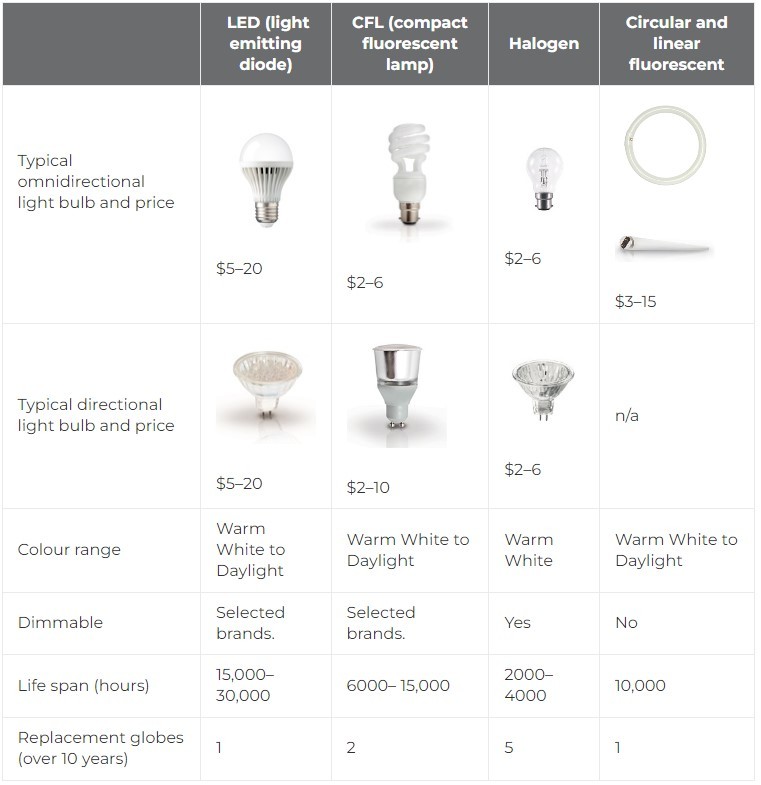Are there different light bulb types?
It's a situation that you've had many times before - you need to replace a light bulb and you head to your local hardware store or supermarket for a replacement. You find the correct area of the shop, however, and are met with a huge variety of light bulbs to choose from... different sizes, shapes, brightness, energy efficiencies and the list goes on. So, how do you know which lighting choice is the right one?

Knowing what you need can be hard with so many options (in answer to the question posed in the title, yes there are different light bulb types!), so to help out we thought we'd let you know a little more about the types of light bulbs available and how they work. We have put some lighting information together below but, if you would like to know more, give our electricians a call at 07 3353 3248.
What are the different light bulb types?
There are four main types of light bulbs generally available on the market:
- Incandescent.
- Halogen.
- CFL.
- LED.
Incandescent Light Bulbs

Incandescent light bulbs are the 'traditional' type, having been the most common light choice for over 100 years. They use a lot of electricity to run and generally don't last very long. In response to these characteristics, a phase-out of incandescent light bulbs commenced in 2009.
Halogen Light Bulbs

Halogen light bulbs run in a very similar way to their incandescent counterparts, however, they manage to use less energy to do it.
CFL Light Bulbs

CFL light bulbs, otherwise known as compact fluorescent lamps, are less costly to run than both halogen and incandescent bulbs, as well as being more energy-efficient.
LED Light Bulbs

LED lights, which are also known as light-emitting diodes, are the best choice on the market as they are more cost-effective and energy-efficient than any other option. As an example of this, it costs around $5 per year to run an LED light in your home (and that's in the rooms with the most traffic!).

How does a light bulb work?

This isn't exactly a straightforward answer - every type of light works a little differently - so take a look at the major types below. Always remember though, that a bulb that produces more heat for the same light output is going to be a less efficient option every time.
Incandescent Light Bulbs
The traditional bulb, the incandescent, creates light by heating the tungsten filament (the wire you can see in a light bulb) to a really high temperature by running an electrical current through it until it glows. The more energy (ie. watts) that is run through the wire, the more light (ie. lumens) is created. On the other side, however, more heat is produced when more energy is used, which means more wasted energy.
Halogen Light Bulbs
Just like an incandescent light bulb, a halogen bulb heats up the tungsten filament to create light... but there is a difference. Halogen bulbs contain halogen gas, which ensures the heating process is sped up. This results in less energy used to light up a bulb, as well as a longer lifespan (as the gas acts as a protector for the filament).
CFL Light Bulbs
Fluorescent tubes, as well as CFL bulbs, work in exactly the same way. A glass tube (which is filled with mercury and lined on the inside with phosphor) has an electric charge generated in it, which excites the vapour and creates UV (ultraviolet) light. The UV hits the phosphor lining, which in turn excites the phosphor and creates light.
LED Light Bulbs
Finally, there are LED lights. These work in a different way than the other 3 options above, which is what makes them more energy efficient. An electric charge makes its way through solid material, as opposed to gas or filament, which engages the electrons located inside. The engaged electrons move very quickly through the solid material, which is what produces light. It is also worth noting that very little heat is produced during this process, which is why very little electricity is wasted.
Light bulb comparison table
The below table provides a thorough comparison between the four light bulb types. The table is courtesy of Energy Rating :

Your local lighting experts
If you have any questions regarding lighting, light bulbs or electrical projects, feel free to give Alltronic Electrical a call today at 07 3353 3248. We would love to discuss your next lighting project.
Resources:
Energy Rating (Light Bulb Buyers Guide): https://www.energyrating.gov.au/document/factsheet-light-bulb-buyers-guide
Energy Rating (Choose Which Type of Bulb): https://www.energyrating.gov.au/lighting/types-of-light-bulbs
All black and white light bulb photos courtesy of Energy Rating.